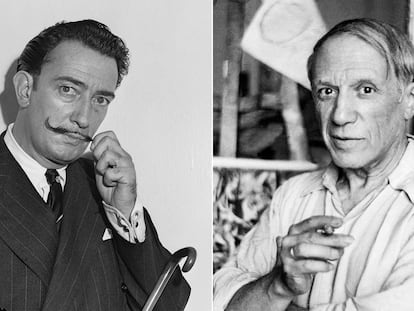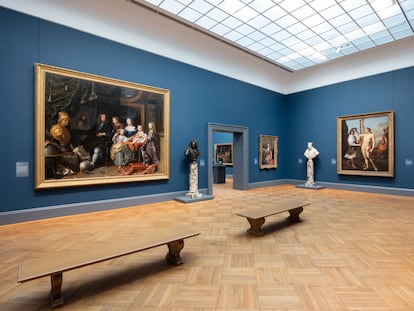Alexander Liberman, the ‘silver fox’ who spent 12 years chasing Picasso, Chagall and Matisse
The celebrated editor would go on to amass over 10,000 portraits of legendary artists, taken in intimate settings over the course of more than a decade, for his masterpiece collection, ‘The Artist in His Studio,’ published in 1960
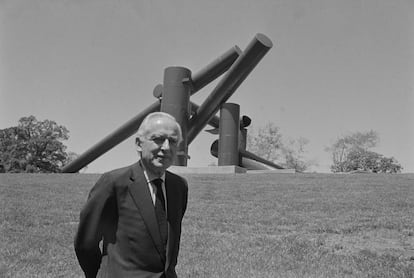
This year, EL PAÍS’s exhibition space at the International Contemporary Art Fair in Spain (March 6-10 at the IFEMA center in Madrid) is dedicated to the relationship between Mallorcan painter Miquel Barceló and Spanish-French photographer Jean Marie del Moral. Over the past four decades, Del Moral has documented, in images, the life and creative trajectory of Barceló — one of Spain’s most renowned contemporary painters — with special attention focused on the artist’s creative process. Since first meeting Joan Miró in the artist’s studio in Barcelona, Jean Marie del Moral has gone on to accumulate a vast body of work featuring images of artists in their studios: from Antonio Saura to Julian Schnabel, to Miguel Ángel Campano and Antoni Tàpies.
The artist’s studio is a classic subject in figurative art. As such, it has served not only to exalt the activity and persona of the artist, but also to elaborate allegorical meanings — that is, to allude to more abstract or ambitious ideas. In The Art of Painting (1966), Vermeer made an allegory of painting itself, or even, perhaps, of the creative act in general. In The Artist in his Studio (c. 1626), Rembrandt depicted himself as dwarfed by his own work, revealing only the blank back of the canvas, in a more-than-sober setting featuring an empty palette hanging on a peeling wall. Gustave Courbet took the opportunity to promote the cause of realism in The Painter’s Studio (1855), while Claude Monet, when portrayed by his colleague Édouard Manet in his floating boat-studio, represented the Impressionist commitment to venturing outside while remaining in the workspace. Matisse would take up this fascination with spaces of artistic creation with his nearly monochromatic work, The Red Studio (1911). Picasso, for his part, never missed an opportunity to be photographed in his studios, with particularly satisfactory results thanks to Hungarian–French photographer Brassaï. And when, in 1956, Gordon Parks photographed the abstract expressionist Helen Frankenthaler for Time, the artist was shown sitting on one of her paintings on the floor in a corner of her studio. More recently, in 2020, when British artist Damien Hirst presented his collection of expensive large-format paintings, titled Cherry Blossoms, he made sure to present himself to the public as artist-at-work, wearing clothes suitably stained with paint, somewhat in the manner of Barceló sitting as subject for Del Moral: “This is real painting,” the resulting images seemed to say, “so these pieces are well worth the asking price.”
However obviously staged these images might be, the myth nonetheless survives: that portraying the artist’s studio is tantamount to capturing something authentic and essential about the creative process. As proof that this relationship continues to be valued, suffice it to recall that this past July, NFTs of photos showing paint stains on the floor of Jackson Pollock’s studio sold for a combined $450,000.
But among the public figures to promote the mythological aura of the artist’s studio as creative quintessence, perhaps the most influential was Alexander Liberman (Kyiv, 1912 – Miami, 1999), thanks in no small part to his photographic exhibition, The Artist in His Studio, which opened in October 1959 at the MoMA in New York City, and was published one year later as a book with the same title. To amass the more than 10,000 photos that the series drew from (only 150 were ultimately exhibited at MoMA), Liberman spent twelve years tracking down some of his favorite artists and photographing them in their studios. Among the 24 creators featured in the exhibit were Pablo Picasso (“undoubtedly the most photographed artist in the world”), Georges Braque, Marc Chagall, Alberto Giacometti, Henri Matisse, Fernand Léger, Jean Arp, Max Ernst and Jean Dubuffet. And (of course) only three women: Natalia Goncharova, Marie Laurencin and Germaine Richier.
The images focus special attention on the instruments of the craft: “Their palettes and work tables, the objects with which they have chosen to be surrounded, are recorded, and their personalities are revealed as they were photographed at work or in conversation,” read the text of the MoMA press release published at the time. In 1960, when Liberman completed the corresponding photobook — a bestseller in its genre — he wrote in its pages: “I tried to reveal the core of their creative act, to show the creative process itself, and thereby to relate painting and sculpture with the mainstream of man’s search for truth.”
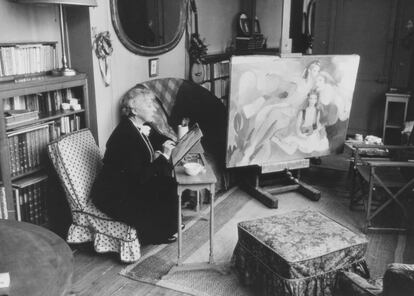
Alexander Liberman was born to a bourgeois and enlightened Jewish family in Kyiv, Ukraine, during the death throes of the tsarist regime. His father was a lumber merchant who went on to work for the Bolshevik government, and his mother directed the Moscow State Academic Children’s Theater. Faced with a changing political situation in the Soviet Union, at the age of 9, and with Lenin’s express permission, Alexander was sent to boarding school in London. In 1924, he moved to Paris, where he was able to join the rest of his family, who had already emigrated from Russia. In France, he studied architecture and painting at the École des Beaux-Arts. Before the age of twenty, he was hired by the weekly magazine Vu, where he worked as Art Director. Aesthetically innovative and politically committed, the magazine showcased works from photographers like Brassaï and Gerda Taro, and provided Liberman with ample contacts in the publishing industry. After the Nazi occupation in 1941, Liberman and his parents fled France for New York. They were accompanied by a childhood friend, Tatiana du Plessix, the glamorous widow of a French baron who had died in the war, and her daughter Francine. Shortly thereafter, Liberman and Du Plessix married and began cultivating a fabulous socialite lifestyle in New York, later recounted by Francine du Plessix in her autobiographical novel Them: A Memoir of Parents. In the book, her stepfather and mother — who made a name for herself in New York as a hat designer for Saks department store — are portrayed as two creative, egocentric and infinitely seductive demigods transplanted to the heart of Manhattan, who prioritized their social relations while neglecting the basic needs of their daughter, Francine, who suffered from severe malnutrition.
In addition to working as a photographer and editor, Liberman was also a visual artist, although his fashionable and minimalist paintings and sculptures — composed by his assistants from instructions he would dictate to them, sometimes by telephone — have perhaps failed to withstand the test of time. It was in the field of lifestyle magazine publishing that Liberman exhibited his most enduring talent. Thanks to his previous experience in France, shortly after arriving in the United States he was hired by Vogue magazine as an assistant for the magazine’s Art Director, Mehemed Fehmy Agha, who would be replaced by Liberman just one year later. Under Liberman’s guidance, the magazine boosted its sales and went from being an exclusive object of select elites to a magazine that was both aspirational and popular, capturing the energy of modern life and amplifying it back to its readers. Liberman had an eye and a flair for harmonizing low and high culture and the artistic and the decorative — he was not afraid to place a model dressed in the latest fashion before a huge Pollock canvas in front of Cecil Beaton’s camera. As well, he had an impeccable sense for choosing photographers — Irving Penn, Richard Avedon, David Bailey, Deborah Turbeville — without neglecting the quality of the text.

After two decades at Vogue, Liberman was promoted to Editorial Director of all Condé Nast publications. In 1971, he hired Grace Mirabella as Vogue’s Editor-in-Chief, to replace Diana Vreeland, whose vision had failed to retain sufficient readership, and in doing so put a more pragmatic spin on the magazine’s approach (the late 1980s would see the reign of Anna Wintour, whose hiring Mirabella learned about from the press). Although Liberman was replaced by James Truman in 1994, he stayed on as Deputy Editorial Director at the magazine, where he was known as “The Silver Fox” until his death in 1999.
Today, Liberman’s work to capture the aura of artistic spaces in images remains a major reference for photographers pursuing similar subjects. In the book It’s Modern: The Eye and Visual Influences of Alexander Liberman (Rizzoli) by Charles Churchward, historian John Richardson, one of the world’s leading experts on Picasso, comments: “I don’t know if Liberman realized how important this would be to people like me. He managed to photograph how [artists] lived, and he had a brilliant eye for eloquent detail.”
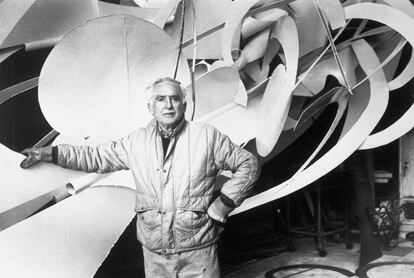
Sign up for our weekly newsletter to get more English-language news coverage from EL PAÍS USA Edition
Tu suscripción se está usando en otro dispositivo
¿Quieres añadir otro usuario a tu suscripción?
Si continúas leyendo en este dispositivo, no se podrá leer en el otro.
FlechaTu suscripción se está usando en otro dispositivo y solo puedes acceder a EL PAÍS desde un dispositivo a la vez.
Si quieres compartir tu cuenta, cambia tu suscripción a la modalidad Premium, así podrás añadir otro usuario. Cada uno accederá con su propia cuenta de email, lo que os permitirá personalizar vuestra experiencia en EL PAÍS.
¿Tienes una suscripción de empresa? Accede aquí para contratar más cuentas.
En el caso de no saber quién está usando tu cuenta, te recomendamos cambiar tu contraseña aquí.
Si decides continuar compartiendo tu cuenta, este mensaje se mostrará en tu dispositivo y en el de la otra persona que está usando tu cuenta de forma indefinida, afectando a tu experiencia de lectura. Puedes consultar aquí los términos y condiciones de la suscripción digital.
More information
Archived In
Últimas noticias
Most viewed
- Reinhard Genzel, Nobel laureate in physics: ‘One-minute videos will never give you the truth’
- Oona Chaplin: ‘I told James Cameron that I was living in a treehouse and starting a permaculture project with a friend’
- Pablo Escobar’s hippos: A serious environmental problem, 40 years on
- Chevy Chase, the beloved comedian who was a monster off camera: ‘Not everyone hated him, just the people who’ve worked with him’
- Why we lost the habit of sleeping in two segments and how that changed our sense of time

